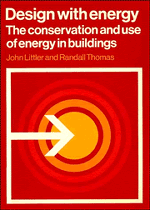Book contents
- Frontmatter
- Contents
- Units, symbols, abbreviations, conventions and conversion factors
- Preface
- 1 Energy and buildings
- 2 Site planning and analysis
- 3 Building design
- 4 Passive solar design
- 5 Active solar heating
- 6 Space heating and ventilation
- 7 Thermal storage
- 8 Wind energy
- 9 Water-supply systems
- 10 Waste disposal and utilization
- 11 Domestic-energy saving
- 12 Housing case studies
- 13 Non-domestic case studies
- Appendix 1 Weather data
- Appendix 2 Thermal performance
- Appendix 3 Interstitial condensation
- Index
9 - Water-supply systems
Published online by Cambridge University Press: 03 February 2010
- Frontmatter
- Contents
- Units, symbols, abbreviations, conventions and conversion factors
- Preface
- 1 Energy and buildings
- 2 Site planning and analysis
- 3 Building design
- 4 Passive solar design
- 5 Active solar heating
- 6 Space heating and ventilation
- 7 Thermal storage
- 8 Wind energy
- 9 Water-supply systems
- 10 Waste disposal and utilization
- 11 Domestic-energy saving
- 12 Housing case studies
- 13 Non-domestic case studies
- Appendix 1 Weather data
- Appendix 2 Thermal performance
- Appendix 3 Interstitial condensation
- Index
Summary
Introduction
Water-supply and waste-disposal systems are related in two ways. Firstly, in the UK, WC (toilet) flushing consumes about 36.5 1/p d or roughly onethird of the average household water use. Secondly, the point of final waste disposal may also be a source of fresh water. About one-third of the public water supply is from rivers, yet 60% of the local-authority sewage discharges to these rivers do not comply with the recommended 20/30 standard. (The Royal Commission on Sewage Disposal (1898–1915) made recommendations which were later adopted on the quality of sewage effluents to be discharged to water courses. The maximum concentration of suspended solids was limited at 30 mg/1 and Biochemical Oxygen Demand (BOD) was limited to 20 mg/1 for a dilution of 1.8 with river water; the Biochemical Oxygen Demand is a measure of the oxygen consumed during the oxidation (stabilization) of organic matter by a mixed microbial population and under aerobic conditions.)
In this chapter we shall briefly deal with water-supply systems and in the following one with waste disposal. Chapter 11 gives some water (and energy) conservation measures.
Virtually all homes in the UK are connected to mains water supplies and are likely to be so in the foreseeable future since planning permission is extremely difficult to obtain for sites that are not serviced. This tends to concentrate development and one of the interests of a group like the Autarkic Housing Project was to study potential changes in land-use patterns if housing was not constrained by availability of mains servicing systems.
- Type
- Chapter
- Information
- Design with EnergyThe Conservation and Use of Energy in Buildings, pp. 289 - 292Publisher: Cambridge University PressPrint publication year: 1984



